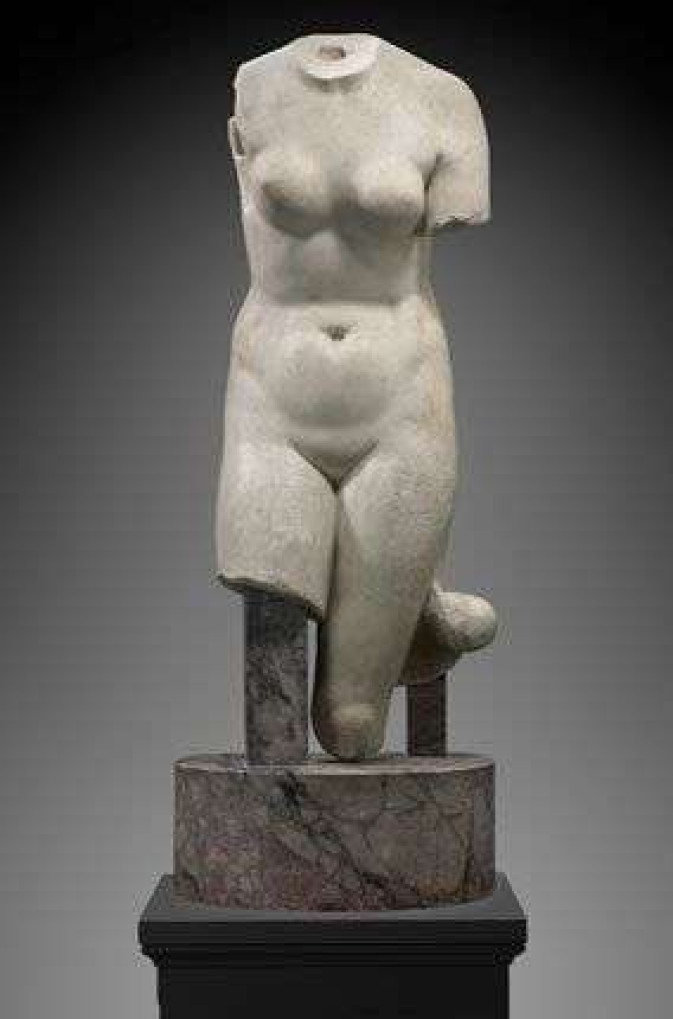'Aphrodite and the Gods of Love' reign at Museum of Fine Arts, Boston
By Chris Bergeron
GateHouse News Service
Patriotledger.com
Posted Nov 19, 2011
Photograph: Aphrodite (Capitoline type), Roman, Imperial Period, 2nd century A.D. Marble probably from the Greek island of Paros.
Throughout Greek antiquity, Aphrodite was worshiped as the goddess of love and beauty, pleasure and fertility.
Sculptors immortalized her beguiling sensuality in marble statues found on Mount Olympus. Devotees journeyed to her birthplace in Cyprus to pray for her favors. Over time, a cult revering her flourished through other goddesses from Venus and the Virgin Mary to mock-divine contemporary exemplars.
Once again, Aphrodite reigns supreme in an extraordinary exhibition at the Museum of Fine Arts that showcases her mysterious fecundity through majestic sculptures, frescoes, pottery, jewelry and coins.
The first major museum exhibit devoted solely to the goddess the Romans called Venus, “Aphrodite and the Gods of Love,” re-awakens an age of pagan belief through some of the finest Classical art in the world.
Visitors will see stunning works depicting Aphrodite as the personification of idealized beauty, grace and feminine guile in a divinity whose image has fired Western culture like an acetylene flame.
Organized by Christine Kondoleon, it features more than 160 works from the MFA’s Greek and Roman collection, complemented by 13 key loans that include several works never displayed before in the U.S.
Kondoleon has used these rare works to transform the Lois and Michael Torf Gallery into a pan-Mediterranean temple that chronicles the ancestry, violent birth and evolution of the goddess whose many brilliant facets illuminated the era.
The museum’s senior curator of Greek and Roman art, Kondoleon explained that Aphrodite was a primal goddess of manifold identities: She was seductress and the first woman portrayed naked. Believers prayed to her for success in marriage, war and lust.
As recorded by the poet Hesiod in 800 B.C., Aphrodite emerged from the ancient mists of a Mesopotamian fertility cult.
One of the earliest Greek gods, she was conceived in bloody strife when the god Kronos castrated his father with a sickle and threw his genitals into the sea. Carried by the waves, a white foam was created from which Aphrodite – whose name means “Born from the foam” – emerged from the sea, seeking refuge on the island of Cyprus.
This deeply held myth was expressed in a highlight piece, a delicate ceramic figure from 400 B.C. of Aphrodite rising from the sea on a giant scallop shell, redolent of the sexual imagery Sandro Botticelli gave his Venus 18 centuries later.
In statues, frescoes and reliefs, visitors will see stunning representations of a mature, beautiful woman, expressed through figurative art of the highest order.
Visitors will see the famed 23-century-old Bartlett head in which Aphrodite gazes straight ahead with unblinking clarity. Crafted more than 30 centuries ago, a terracotta figurine from Mesopotamia covers her breasts with Bronze Age modesty.
A half-draped goddess reaches out to celebrate a military victory. Aphrodite strides from the sea with the muscular determination of a farm girl mowing fields of wheat.
Greeks and Romans portrayed Aphrodite on a scale befitting a goddess who started the Trojan War.
The lifesize “Head of Aphrodite,” also called “the Bartlett Head,” fuses human beauty with a divine ideal in the 23-century old face that is as perfect and enigmatic as Venus de Milo.
APHRODITE AND THE GODS OF LOVE
At the
Museum of Fine Arts,
465 Huntington Ave.,
Boston,
through Feb. 20, $22 adults; $20 seniors and students 18 and older; free for youths 17 and younger during non-school hours; admission includes two visits in a 10-day period.
617-267-9300,
www.mfa.org.
“Aphrodite and the Gods of Love” is organized by the Museum of Fine Arts, Boston, in association with the J. Paul Getty Museum. When the exhibit closes at the MFA on February 20, it will make its way to the Getty Villa in Malibu, California where it will be in view from March 28 to July 9. After that it will go to be displayed in New Mexico at the San Antonio Museum of Art from September 15, 2012 to February 17, 2013 and then at the Philbrook Museum of Art in Tulsa, OK from March 10 to May 26, 2013.
